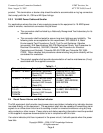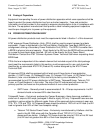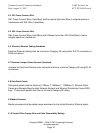Common Systems Connection Standards AT&T Services, Inc
Date: August 31, 2007 ATT-TP-76450, Issue 9
Copyright ©2004 – 2006, AT&T Knowledge Ventures
All rights reserved
Page 12
3 Synchronization/Timing Standards
The Building Integrated Timing Supply (BITS) concept is the method of providing Phase and
Frequency synchronization. The BITS plan details that each office have one Primary
Reference Source (PRS)/(Stratum-1) traceable office master clock called the BITS. Under the
BITS concept, each/every timing capable Network Element (NE) in the office should derive its
timing from that single source within the office. A timing capable Network Element is defined as
any digital equipment piece that is capable of conforming to the BITS concept by accepting
timing from an external source. A Network Element is still timing capable even if it is not
currently configured or equipped to accept external timing via AT&T approved, adequately
protected wire-wrap connections; as long as the option exists to allow it to be so equipped.
3.1 Termination of timing leads
All critical network element timing signals lead termination points shall terminate only on the
BITS/TSG office master shelf or one of its expansion shelves or a Remote Master shelf
equipped with oscillators that can maintain phase alignment.
3.2 Primary and Secondary Interfaces
A Network Element should be equipped with separate external primary and secondary timing
interfaces.
3.3 Clock output lead cabling
Clock output leads to network equipments shall be cabled with physically diverse routing. The
primary and secondary input leads for a NE must have physically separate paths/routes with a
minimum of six-foot separation. If physically separate paths/routes do not exist, running leads
on opposite sides of the cable rack is acceptable.
External Clock Wire Wrap pins on the backplane of shelf are the AT&T standard and preferred
method but the use of a wire wrap adapter kit or equivalent is acceptable. To be compliant to
GR-1244, R3-10, no DB or RJ type connectors would be allowed
Each terminal shall consist of three pins designated “TIP”, “RING” and “SHIELD.”
Note that while GR-1244 R3-10 [11v2] and R3-11 [108] do not require that the wire-wrap
terminals be located on the backplane of the equipment, AT&T requires hardware,
backplane chassis integration, rather than having the terminals located close to the equipment
in order to facilitate trouble-shooting and maintenance procedures. Also note that R3-11 [108]
applies independent of whether the NE itself supports the external timing mode (e.g., it would
apply to a line-timed NE that supports the capability to generate an external timing signal for
use at another NE).
3.4 Redundancy of timing inputs
Each Switch (Host, or Remote, where applicable) or each Transport Network Element requiring
redundant timing inputs (for instance, a SONET ADM/DCS) shall be individually timed from the


















